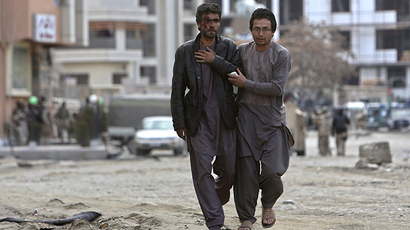Afghan security crisis: 13 years & $100 billion after US entry
The Taliban pre-electoral campaign of bloodshed continues in Afghanistan, as six die in an attack on the interior ministry in Kabul. As the first democratic transfer of power approaches, the country is in terrible shape ahead of the 2014 US pullout.
A suicide bomber attacked the interior ministry compound in the capital on Wednesday, just three days before polls open, amid months of increasing violence from the country’s extremist Taliban insurgency.
The bomber wore military uniform to avoid detection and security checks, local authorities reported. This, after earlier on the same day, the terrorist group killed nine people they had abducted several days prior to the incident. One of them was a candidate running for provincial office.
The atrocity took place hours after the group warned Afghans to stay away from the election offices this Saturday, where people will be picking from a list of eight candidates to replace incumbent President Hamid Karzai.
Although he is banned by law from seeking another term, Karzai, who has been cooperating with the occupying US forces, has been subject to Taliban threats and criticism from the occupying forces themselves. His trust in the US has dwindled over the past 10 years, and he believes the same is true for American trust towards him. As a result, a long-awaited bilateral agreement with the US, on leaving more of their troops behind until 2024, has still not been signed.
RT correspondent Lucy Kafanov has been in Afghanistan reporting on the latest in the bloody run-up to the elections. Authorities near Bagram Airfield – the largest US base in Afghanistan, located in Parwan Province – say all roads leading from there to Kabul have been blocked and will stay that way until after Saturday’s election.
Hundreds of cars stranded, trying to enter #Kabul. Entry to capital via Old Bagram road and New Bagram road blocked pic.twitter.com/GbBZsr4c1l
— Lucy Kafanov (@LucyKafanov) 3 апреля 2014
The local Khaama Press news site is reporting that the Taliban claims to have obtained a document outlining in detail security plans for the elections. It contains specifics on voting stations in each province. The group is said to have published a number of photos of the plans.
Kafanov also managed to capture the current state of Afghanistan, as billions of misspent US dollars reveal themselves in widespread lack of security, rampant malnutrition, underfunded humanitarian programs and abandoned projects and equipment. Below is a video of one such US junkyard.
100 billion spent and little to show for it
Many were vehemently opposed to the US occupation of Afghanistan back in 2001, from people back home to Afghans themselves. But after 13 years of fighting the Taliban insurgency, while promising democracy and prosperity, Western forces have not created conditions for a pullout that would make the whole operation seem worthwhile in the first place. The clock is ticking: the vast majority of US forces will leave the country by the end of 2014, with local forces left to deal with crippling extremism, joblessness, lack of infrastructure and basic healthcare, plus education problems.
The US has shown it is keen on improving the status quo to justify its presence in the country. And it spent around $100 billion proving its point, with projects in healthcare, infrastructure and a number of other sectors. However, the latest auditing reports have said a lot of this cash is being wasted, or swallowed by corruption.
"I'm worried about the future. The soldiers are leaving and jobs are disappearing from Bagram," Ashrat Ullah, 18, told Lucy Kafanov.
US & NATO allies spent billions of dollars on road reconstruction in #Afghanistan. Yet this remains a common sight pic.twitter.com/RkFyWZRXrt
— Lucy Kafanov (@LucyKafanov) 1 апреля 2014
Access to healthcare in Afghanistan is one of the most pressing issues, with many deaths occurring as a result, according to figures provided by Doctors without Borders. Malnutrition remains one of the deadliest killers of young children, while the number of Afghans who are in dire need of life-saving support stands at five million.
Access to healthcare across the country remains an issue, 1 in 4 Afghans lost a loved one as a result, MSF tells me pic.twitter.com/gdAvPaa5J4
— Lucy Kafanov (@LucyKafanov) 2 апреля 2014
The rate of drug abuse has also been on the rise (with heroin production peaking), together with unemployment and the destitution caused by three decades of war. Various glass pipes and other drug paraphernalia are openly sold on the streets. Only one in 10 drug addicts receives treatment, with the programs vastly underfunded.
This is hardly surprising for a country with rampant unemployment and those with jobs earning on average an estimated $410 annually.
A lack of often basic infrastructure is another exacerbating factor. One of the most ambitious US projects in Afghanistan has been road construction, with $2 billion of USAID money being poured into it. However, the country is plagued with many worn-out and bumpy roads and you can’t help but wonder where the money has gone. As Kafanov reported, 10,000 miles of roads in total are in a completely parlous condition. Part of the problem lies in shifting US attitudes toward aid: It has directly been taking money away from their own projects and giving it to Afghan officials to spend as they see fit. It’s worth mentioning that none of the 16 government ministries are trusted institutions for dealing with US money, according to the Special Inspector General for Afghanistan Reconstruction, John F. Sopko, who told the Washington Post on Monday that the country has “a very poorly run and corrupt Ministry of Justice, attorney general’s office and judiciary. So it’s very difficult for us to reach out and grab a contractor or subcontractor.”
The strategy from the beginning was to spend a lot of money on big projects, in an effort to win local hearts and minds. Nevertheless despite evidence of the staggering mismanagement of these funds, Washington continued to pump money into the country.
One of the most striking examples is the military headquarters in the south-west. It cost America a hefty $34 million to build the compound. It has a briefing theatre and very comfortable facilities. But it has never been used by the occupying forces, so all that equipment and money will have gone to waste when the facilities are torn down after troop withdrawal.
Regarding casualties, the ISAF forces are said to have sustained 3,429 casualties in total, while 13,729 Afghan armed forces and police have been killed. But even those numbers put together don’t make up the civilian casualties in the 13-year campaign.
Children at an Internally Displaced Person's camp on the edge of #Kabul. More than 600K ppl displaced in #Afghanistanpic.twitter.com/aN1UIgpK8T
— Lucy Kafanov (@LucyKafanov) 1 апреля 2014
There are over 350,000 Afghan soldiers serving at this time, but the death toll is almost 10 every 24 hours. The enduring confrontation with the Taliban is eating away at the local military bit by bit. And it is clear that without American presence, they are doomed.
Although it’s evident that, if anything, efforts against the extremist insurgency need to be stepped up, the simple cost of maintaining the army and the police as they are is an estimated $6 billion annually – well in excess of the nation’s entire budget.
Without maintaining – let alone improving – this balance, Afghans continue to experience the sharp end of the conflict. 2013 saw a steep 14 percent rise in casualties, according to the United Nations, who added that this was the deadliest in five years for women and children. One in four Afghans has endured a death in the family during the 14-year occupation, Doctors without Borders (MSF) reports.
The objectives of removing the Taliban and curbing extremism, while helping Afghanistan rebuild its infrastructure and become a completely self-sufficient democracy, have not been achieved.
Richard Becker of the anti-war Answer Coalition told RT that “the security situation is so bad that the government has had to order some of the main restaurants and clubs to be closed” ahead of the elections.
“There is widespread lack of security throughout the country. There’s no real assurance that the Afghan national army the US has invested so many billions of dollars in are able to secure the situation inside the country.”














